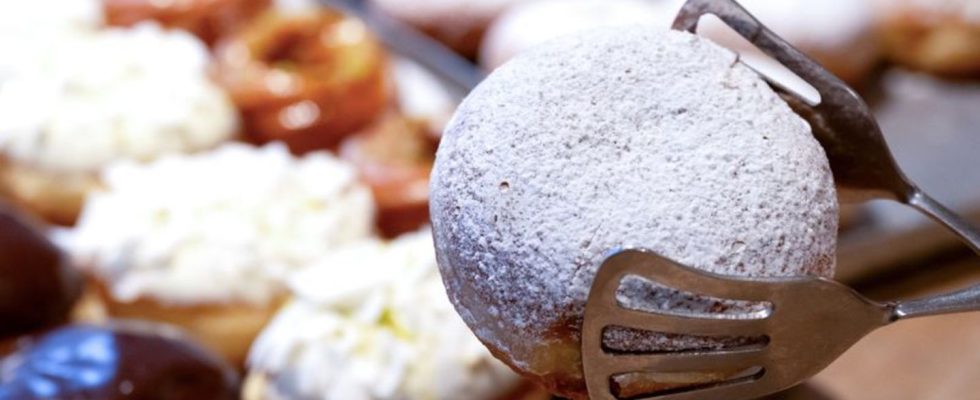They are called donuts, donuts, pancakes and so on: filled yeast particles that are fried in fat. During the carnival season, millions of them cross the bakery counters again.
What do you call a fried flat dumpling made of minced meat – meatball? Meatballs? Klops? Meatballs? Minced loaf? Or something completely different? There are a few things in German where you can learn something about the diversity of the language and determine the origin of the person speaking.
In February, the following question is particularly suitable in German-speaking countries: What is the name of a “ball-shaped pastry made from yeast dough baked in floating fat and usually filled with jam”?
The baked goods, which many – but not all – call “Berliners”, are a delicacy that is traditionally eaten at Carnival (and New Year’s Eve). It is usually decorated with powdered sugar or icing. Jewish cuisine knows “Sufganijot” (often written with “y” instead of “j” or just with “i”), a very similar fatty pastry that is served at Hanukkah.
More than just fruit filling
In addition to the usual fruit filling, the “Berliner” also has eggnog, chocolate sauce or vanilla pudding filling. Fans love the yeasty-sweet scent and the golden brown color – only the collar should be pale, which is the approximately thumb-thick edge around it, which is ideally even. Of course, as with any food, there are many people who don’t like it at all and who even detest the calorie bomb.
According to the Central Association of the German Bakers’ Trade (citing GfK figures), more than 350 million “Berliners” are sold every year in Germany alone. The predominant name probably comes from the fact that, after a centuries-long history, a baker from Berlin in the 18th century ensured that the shortbread spread further.
“There are essentially four different names in German-speaking countries,” says linguist Stephan Elfreude from the University of Salzburg, who once co-authored the relevant popular science booklet “Grüezi, Moin, Servus! How we speak where.” “In the east of Germany they say “Pfannkuchen”, in the west – i.e. northwest, in the southwest and in the very west, including East Belgium – “Berliner”; in Bavaria, Austria and South Tyrol “Krapfen” or “Faschingskrapfen” and mainly in Hesse “Kräppel” , which is a phonetic variant of doughnut.”
“Berliner” and “Pfannkuchen” are actually just abbreviations for “Berliner Pfannkuchen”. In Baden-Württemberg and the Palatinate/Saarland area, some also said “Fastnachtsküchle” or “Fastnachtsküchelchen”.
Up to ten different words
According to Elfreude, comparatively few people in North Rhine-Westphalia still say “Berliner Ballen” (especially in the Ruhr area) or “Puffel” (in the Aachen area: “Öcher Puffel”). But these areas are, so to speak, overrun by the “Berliner”. “Depending on how you count, you can get up to ten different words in total.”
And which term in German do most of the approximately 90 million native speakers use? “In our 2007 survey, almost half of the people said ‘Berliner’, about a third said ‘doughnuts’, ‘Faschingskrapfen’ or ‘Kräppel’ and a good 17 percent said ‘pancakes’,” says Elfreude, also co-author of the book “German Language of the Present – An Introduction”. It is therefore clear to linguists “that none of the terms could claim to be the only High German one.”
“The vocabulary of standard German is perhaps around 95 percent uniform – but not 100 percent,” emphasizes the German studies professor. “In some areas there is a juxtaposition of different words that mean the same thing.”
Each dialect basically has its own vocabulary in addition to its own grammar. “In standard German, regional vocabulary has been preserved, especially in expressions that are also often used in everyday language. This particularly applies to words for fruit, vegetables or certain dishes.” Think, for example, of the blueberry/blackberry/blueberry/cranberry, of carrots/carrots/yellow turnips/turnips, of the meatball/bulette and so on.
Pancakes or lentils are also a good example, as Elfreude explains. “A sweet omelette is usually called “pancake” in Germany, but not where “pancake” means something different: you then have to say “egg cake” or the originally Sorbian word “plinse” in order not to get the wrong treat. “
Bad surprise with the filling
Back to the “Berliner Pfannkuchen”, i.e. the doughnut. In some regions there is a custom of filling individual specimens with mustard or onions instead of jam, for fun and as a little nasty surprise. Some bakers have also attracted media attention in recent years by offering variants that are difficult to get used to during carnival season.
The baker and confectioner Florian Perkmann from Miesbach in Upper Bavaria already had a Leberkas donut or a sausage donut in his range. And in Nidda, Hesse, the Rank family and bakery has had the Mett-Kräppel and the Tuna-Kräppel on offer in recent years, although they are also often spelled with an “e”. This year there is the so-called Flaaschworscht-Kreppel (with meat salad).

